
Czech Republic - electric locomotives and multiple units of České dráhy
For a full scale picture, please click on the picture shown !
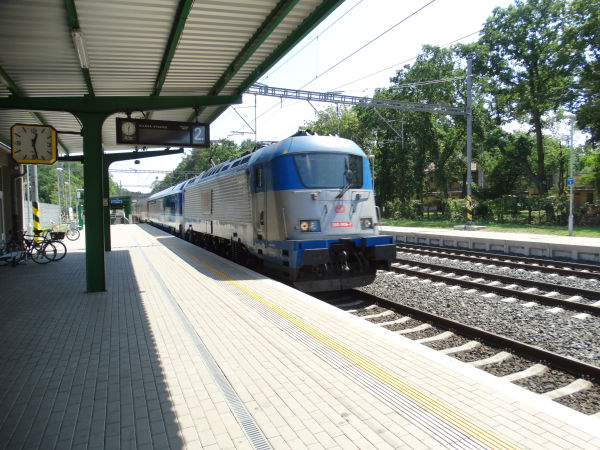
The class 380 or Škoda type 109 "Zatopek" is the finest and fastest locomotive built in Czech republic so far. In Czech they are known as class
380, in Slovakia as ZSSK class 381 and in Germany as Br102. It's a 200 km/h fast machine built in 2008-2010 with a power rating of 6400 kW. It's a
three electric systems machine capable of running all the way from Germany through Czech republic and Slovakia to for example Hungary.
Emil Zatopek was a famours Czech runner in the 1950s.
Picture of a "Zatopek" rushing past the station of Praha-Klánovice 15.7.2018 by Ilkka Siissalo.
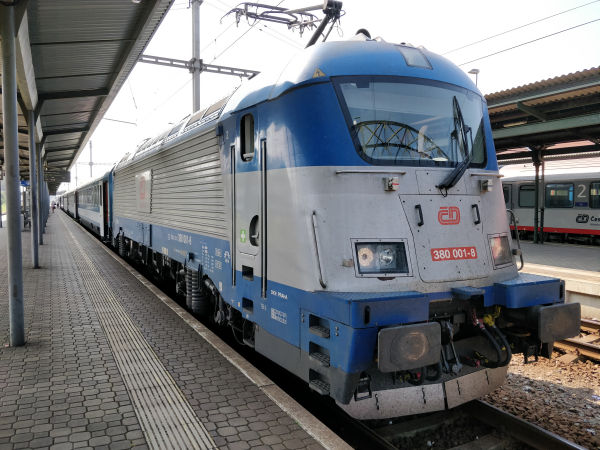
One of the class 380 "Zatopek" locomotives.
Picture from Novy Bohumin 23.8.2019 by Markku Salo.

A České dráhy class 150 locomotive in front of an InterCity train. This type is the former ČSD Class E 499.2 built by Škoda
in 1978. Class 150 is known by several nicknames, including "sewer rat" or "banana".
Picture from Praha hlavní nádraží (Prague main station) 3.9.2020 by Markku Salo.
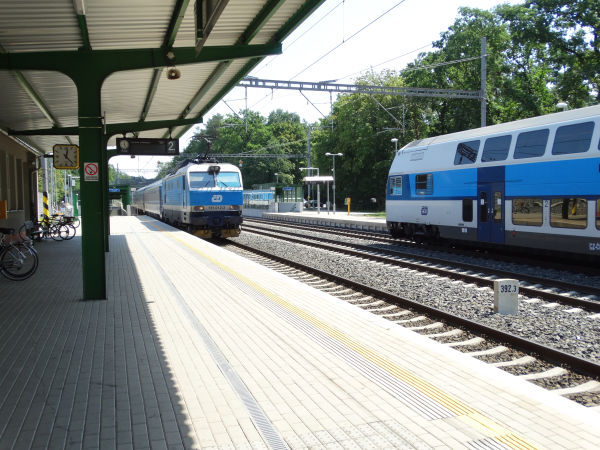
A České dráhy class 151 electric locomotive is rushing really fast past the station of Praha-Klánovice while at the same time a regional double decker train
of the class 471/971 "CityElefant" is stopping at the platform behind. Class 151 locomotives are considered as "prime" locomotives in the country.
They are rebuilt and modernised class 150 machines, now capable of running fast passenger trains at 160 km/h. The class 150 dates back to 1978 and
it is a 140 km/h fast machine intended mainly for the fast Praha-Ostrava route. 13 of them were totally rebuilt to become modern thyristor
technology machines of this class 151 during 1996 to 2002.
Picture from Praha-Klánovice station 15.7.2018 by Ilkka Siissalo.
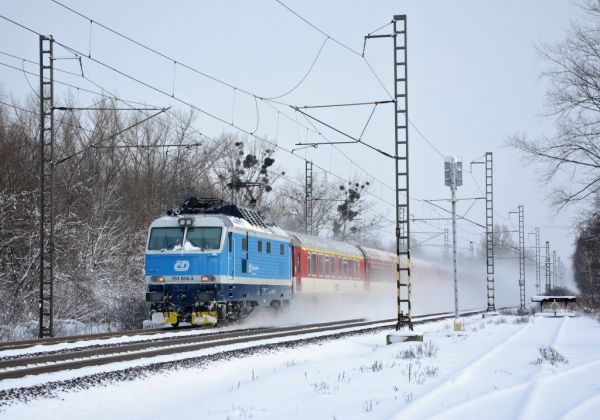
A České dráhy class 151 electric locomotive no. 016 in full speed on its route from Bohumin to Ostrava main station.
Picture from near Ostrava 17.1.2021 by Petr Štefek.
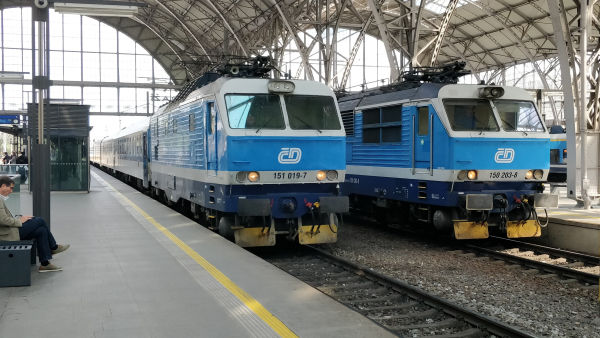
České dráhy class 151 and class 150 side by side. They look practically identical, which is no wonder since class 151 locomotives are
just modernised class 150 machines as discussed above.
Picture from Praha hlavní nádraží (Prague main station) 3.9.2020 by Markku Salo.
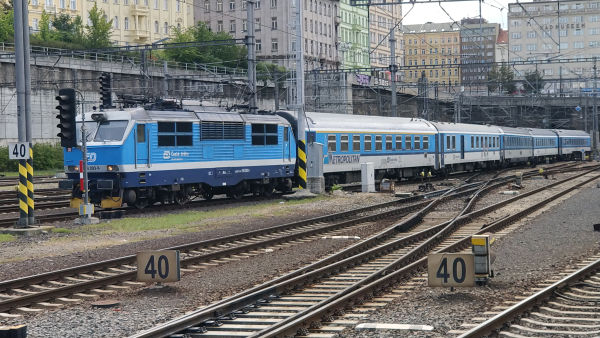
České dráhy EuroCity international train with a class 151 locomotive is approaching Praha (Prague). The Metropolitan is EuroCity 279
running between Budapest and Prague.
Picture from Praha hlavní nádraží (Prague main station) 2.9.2020 by Markku Salo.

A České dráhy class 163 electric locomotive pulling a regional express train past the station of Praha-Klánovice. These are universal locomotives
for DC current only and they are basically the same as the class 372 or the German class Br180, but without the equipment needed for driving under
15 kV AC. They were built by Škoda in the 1990s. Its top speed is 120 km/h (class 162 is otherwise the same, but they are geared for 140 km/h)
and its power rating is 3480 kW.
Picture from Praha-Klánovice station 15.7.2018 by Ilkka Siissalo.
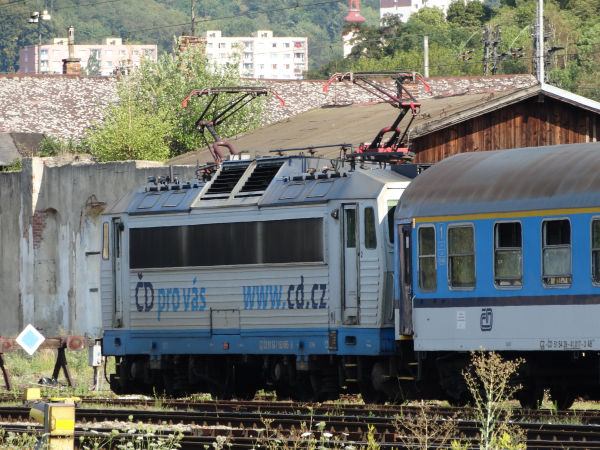
Class 163 locomotives can be found in front of passenger coaches also in this kind of tapings.
Picture from Usti nad Labem 15.7.2018 by Ilkka Siissalo.
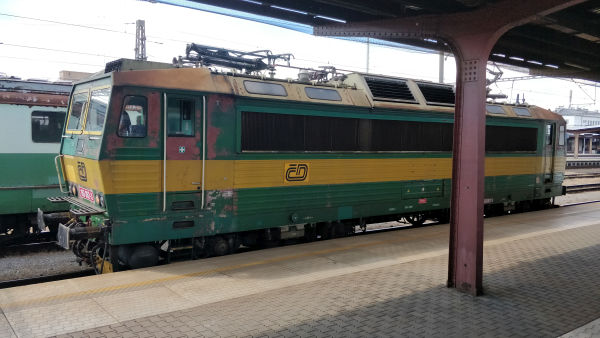
This class 163 machine is still in its communist Czechoslovakian time paintings - and would definitely need a repainting.
Picture from the station of Kolín 3.9.2020 by Markku Salo.
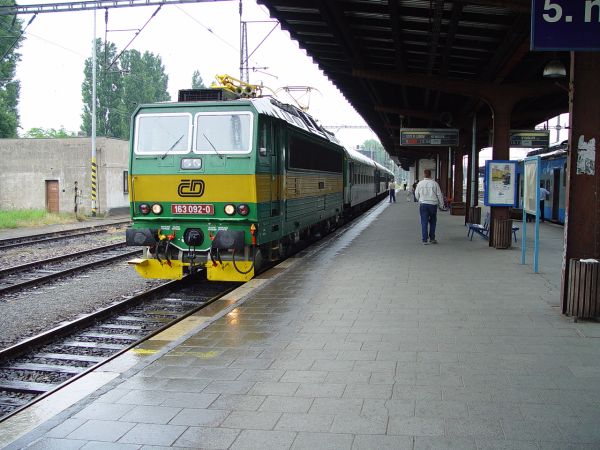
Another class 163 machine also still in communist-time paintings, waiting here in front of a regional train for its departure time
from Kolin to Usti nad Labem.
Picture from Kolin 1.6.2003 by Ilkka Siissalo.
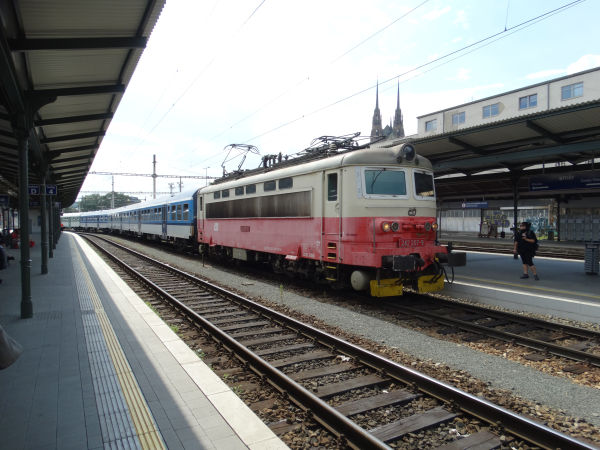
České dráhy class 242 old electric locomotive is bringing a regional express train to Brno. Class 242 is former Czechoslovakian class 5 499.02.
They are Škoda locomotives from 1975-81 and further developments of the class 240. They differ from their predecessors, class 240, for example
so that they have a fully metallic chassis. Top speed is 120 km/h and power rating is a modest 3080 kW at 64 km/h. České dráhy wants to modernise
these and subsequently use in push-pull trains.
Picture from Brno station 14.7.2018 by Ilkka Siissalo.
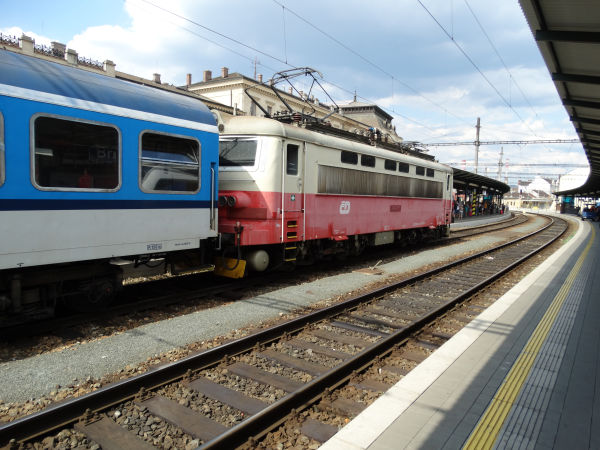
The same class 242 locomotive as in the picture above, seen from the other side as the train passed.
Picture from Brno station 14.7.2018 by Ilkka Siissalo.
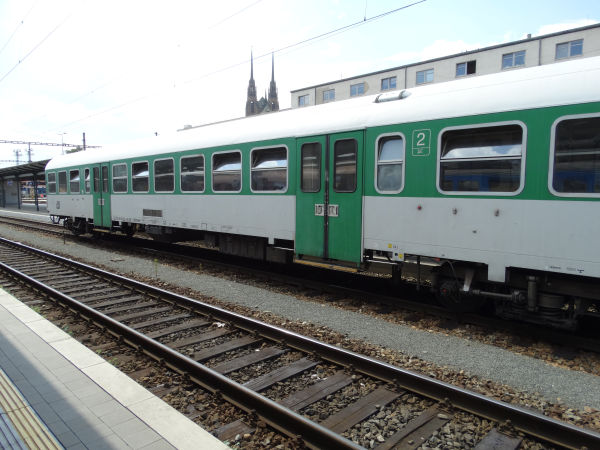
This old class Bdmtee regional train coach was the last one in the same train, which was pulled by the locomotive seen in two pictures above.
In 2018 most Czech coaches are already repainted in current blue and white colours, but it is still possible to see some which are in the old
communist time paintings.
Picture from Brno station 14.7.2018 by Ilkka Siissalo.

Class 362 electric locomotives are today among the most common in front of prime express trains, like here leading an international EuroCity
train to Brno main station. These were built by Škoda 1999 to 2010 in two series. It is a further development of earlier very similar locomotives.
In 1990 the first locomotive of the last series of Škoda type 69 E locomotives was modified to run 160 km/h instead of the formerly 120 km/h and
this became the first one of this class, 362.001. Later on, locomotives of the class 363 were modified by taking bogies and some other undercarriage parts
from faster locomotives and thus increasing their top speed from 120 km/h to 140 km/h. After these modifications these machines were classed as 362 instead
of the original class number 363.
The power rating of class 362 is 3060 kW.
Picture from Brno station 14.7.2018 by Ilkka Siissalo.

Another class 362 electric locomotive, here in a little bit different painting. It's in full speed passing the small station of Praha-Klánovice.
Picture from Praha-Klánovice station 15.7.2018 by Ilkka Siissalo.
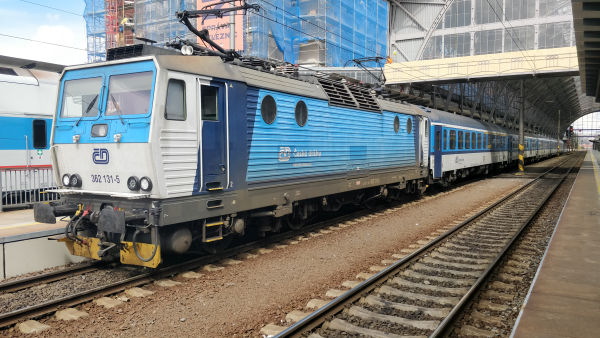
This class 362 machine has been quite recently refurbished and repainted.
Picture from Praha hlavní nádraží (Prague main station) 2.9.2020 by Markku Salo.

České dráhy class 371 "Gottlieb" is a former German Democratic Republic's DR's locomotive of their class Br230, later DB class Br180.
When the German Deutsche Bahn felt that they don't need these machines any more, they were all given to the Czechs who already had
almost identical class 372 machines. There are seven of these formerly German machines. Top speed is 160 km/h and they can operate
in Germany, Czech republic and Slovakia.
Photo from Praha hlavní nádraží, Prague main station 15.7.2018 by Ilkka Siissalo.
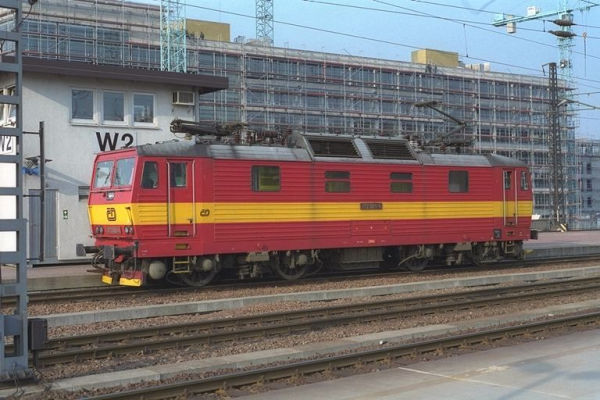
České dráhy 372 005-9 at Dresden Hbf (Germany). For international trains between the two countries DDR and Czechoslovakia the two communist governments
decided to order practically similar locomotives capable of driving under both the German 15 kV AC as well as the Czechoslovakian 3 kV DC. This is one of
the that time Czechoslovakian machines. The real series after prototypes consists of machines 372.002 to 015 and they were built in 1991. Much of
the technology used comes from the earlier series 163, 263 and 363.
19th April 1996. Photo by Erik Hjelme.
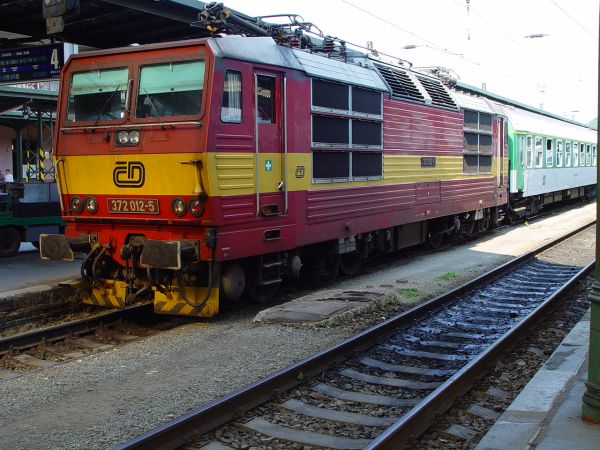
Another one of the original České dráhy class 372 locomotives, here still in its original painting. This is the 372 no.012.
Picture from Praha Masarykovo 1.6.2003 by Ilkka Siissalo.

This is one of the newest locomotives of České dráhy Cargo, a Siemens Vectron of the class 383. The taping of the side of the locomotive
commemorates 100 years of independence of the Czech Republic. Beautiful, isn't it?
Picture by Michal Makalouš, December 2018.
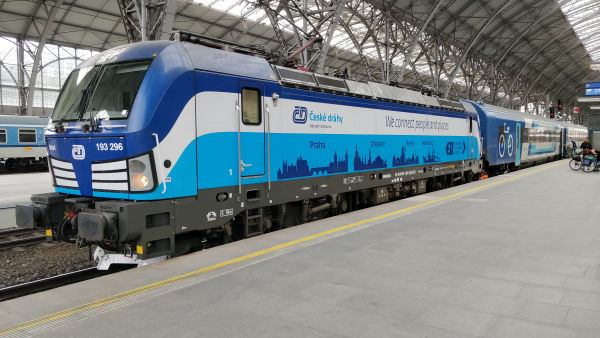
This Siemens Vectron locomotive is one of the newest operating for České dráhy, but its not owned by ČD, but by ELL, European Locomotive
Leasing and it is in German register as German Baureihe (class) 193. Here it is seen in front of an international EuroCity train running
from Budapest via the Czech Republic to Germany. The coaches on the right are very new Hungarian wagons.
Photo from Praha hlavní nádraží, Prague main station 5.9.2020 by Markku Salo.
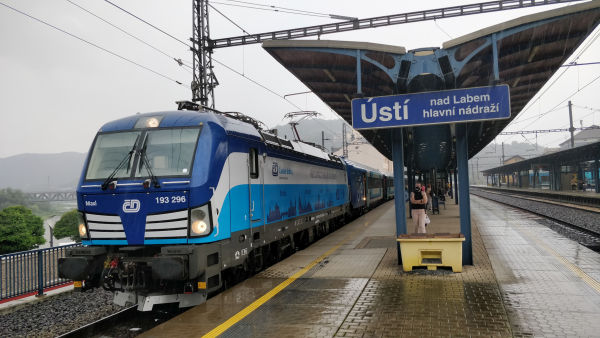
The same EuroCity train with its ELL Br 193 locomotive as above, but now seen at Ústí nad Labem, very close to the border to Germany.
Picture from Ústí nad Labem station 5.9.2020 by Markku Salo.
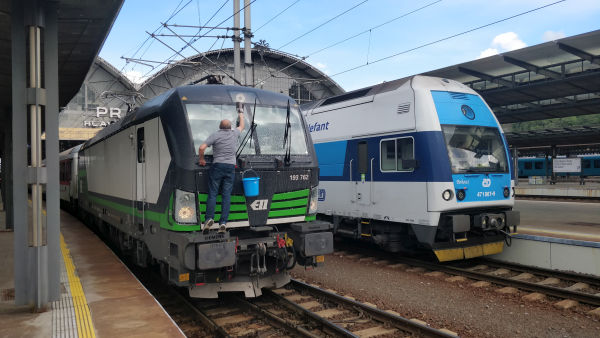
This is yet another Siemens Vectron Br 193 owned by European Locomotive Leasing ELL and running for České dráhy, but it has not yet been
taped in the colours of ČD. These are the company colours of ELL.
Photo from Praha hlavní nádraží, Prague main station 2.9.2020 by Markku Salo.

Also this new Siemens Vectron is registered in Germany as German Br193 although it works for ČD.
Picture from Berlin, Germany 21.6.2023 by Markku Salo.
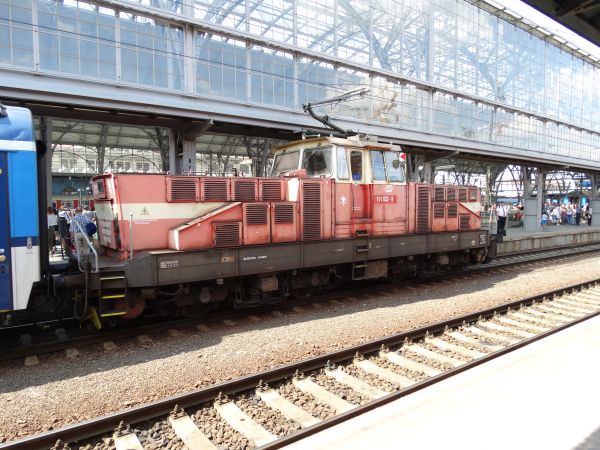
České dráhy class 111 electric shunter. They were built 1981-82 and their nickname is "flatiron". It is a 3 kV DC only machine with a top speed of 80 km/h
and a power rating of 772 kW. They are used in light passenger line traffic as well as for shunting.
Picture from Praha (Prag) main station 15.7.2018 by Ilkka Siissalo.

A class 111 "flatiron" shunter like they used to be, still in old communist time colourings.
Picture from Praha (Prag) main station 31.5.2003 by Ilkka Siissalo.
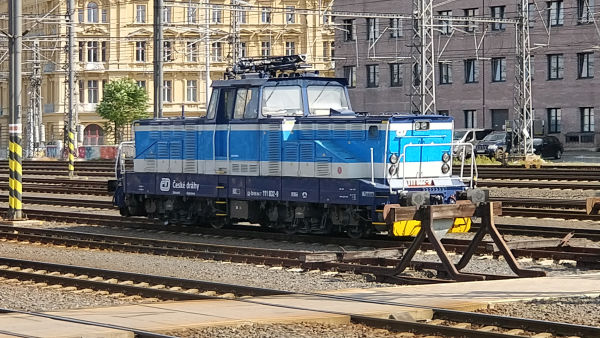
Yet another class 111 electric shunter, but this one has now been thoroughly modernised and repainted.
Picture from Praha hlavní nádraží (Prague main station) 3.9.2020 by Markku Salo.

Class 111 and 110 switchers are practically the same machines, but 110 is the very first production batch from 1971-73.
Class 111 is then the newer series from 1981-82. This is still one of the first batch locomotives - and it seems to be
in pretty bad shape.
Picture from Praha-Masarykovo 1.6.2003 by Ilkka Siissalo.
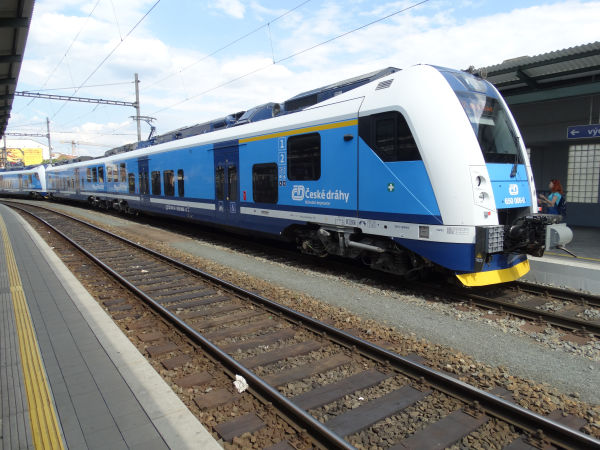
České dráhy class 650 electric multiple units are among the newest rolling stock material of the country. Their official nicknamne is "RegioPanter".
They have been built by Škoda Vagonka (Former Vagonka Studenka) since 2011 and they are available in three lengths, classes 440, 640 and 650.
Unofficial nicknames include "Harmonika" (Harmonica), "Metro" and "Hradubické metro". Officially the train is called Škoda 7Ev. 42 units have been built
+9 on order, the capacity of the trains is depending on the version 147 to 350 seats. Power rating of the train is 1360 kW to 2400 kW depending on
the version and top speed is 160 km/h. Their main use is in regional express trains. This picture shows the shortest version, class 650.
Picture from Brno station 14.7.2018 by Ilkka Siissalo.
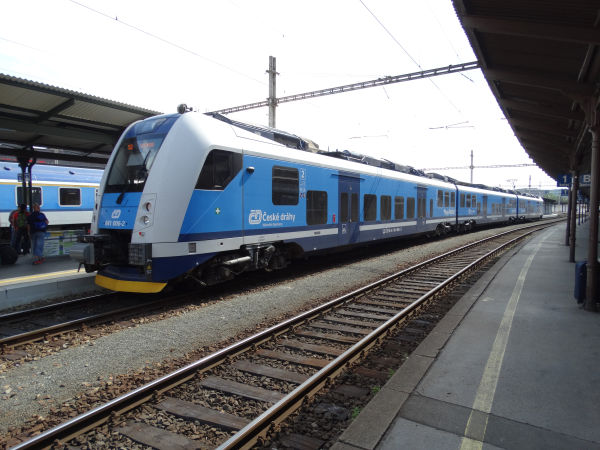
Another RegioPanter, but this time the three coach variant, class 641.
Picture from Brno station 14.7.2018 by Ilkka Siissalo.
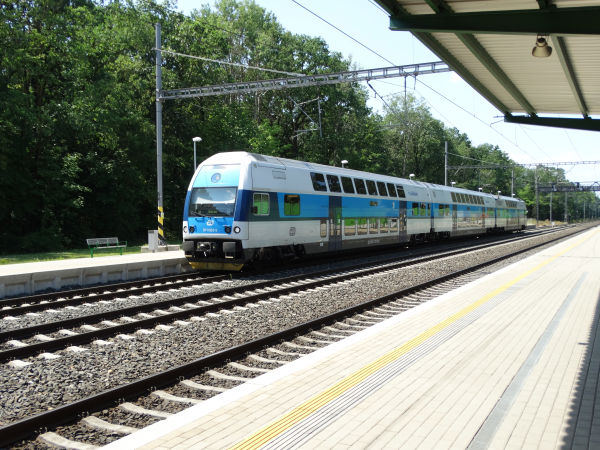
This is the so called CityElefant, a double decker train built by Škoda. The first coach in this picture is a motorless driving trailer
of the class 971, and power car, here at the end of the train, is called class 471. These are 2000 kW strong and 140 km/h fast regional
trains, which Škoda has sold also to Slovakia, Lithuania and Ukraine. It has 287 seats in 2nd class and 23 seats in 1st class. This
train was en route from Praha to Kolin.
Picture from Praha-Klánovice station 15.7.2018 by Ilkka Siissalo.
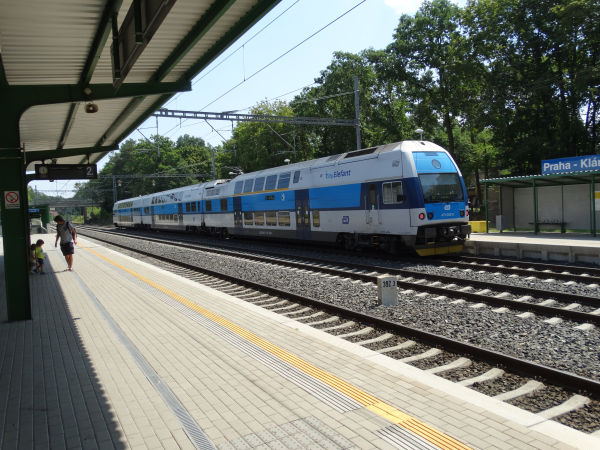
The same CityElefant as in the picture above, but now seen from the side of the motorised coach, class 471.
Picture from Praha-Klánovice station 15.7.2018 by Ilkka Siissalo.
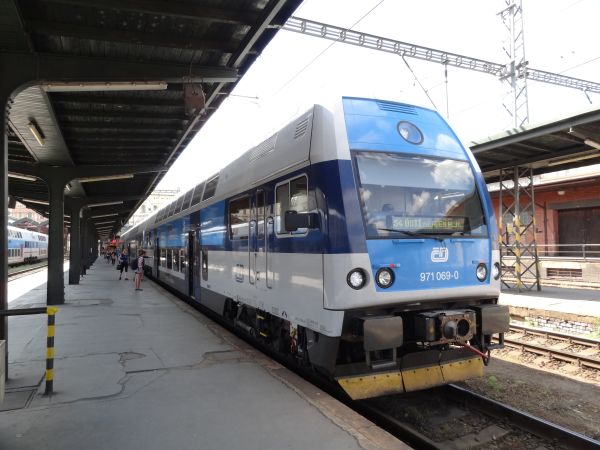
A similar CityElefant, ready to leave from Praha Masarykovo towards Usti nad Labem in northern Czech republic.
Picture from Praha Masarykovo station 25.5.2012 by Ilkka Siissalo.
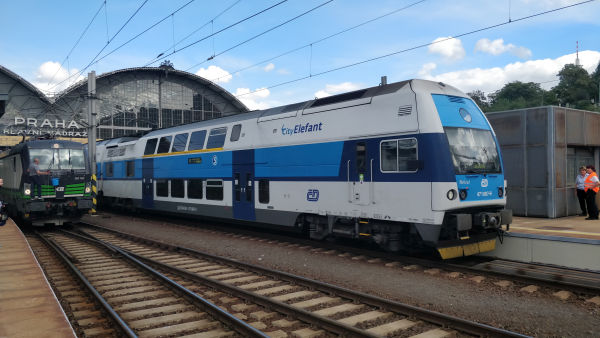
A closeup picture of yet another CityElefant painted in the newest painting scheme.
Picture from Praha hlavní nádraží (Prague main station) 2.9.2020 by Markku Salo.
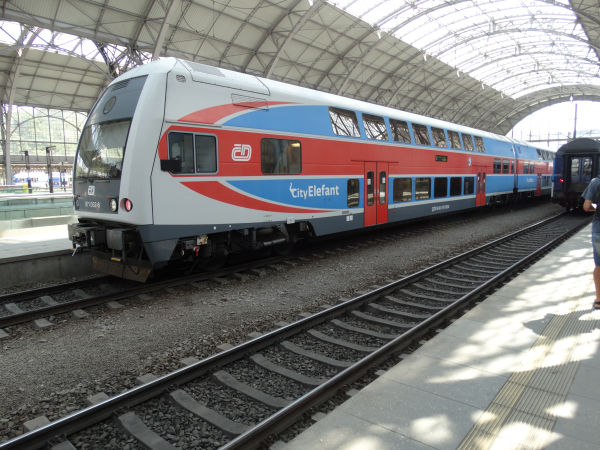
A similar CityElefant, but this one is still wearing an older colouring scheme.
Picture from Praha hlavní nádraží, Prague main station 15.7.2018 by Ilkka Siissalo.

One more CityElefant, wearing the old colouring scheme.
Picture from Praha hlavní nádraží (Prague main station) 3.9.2020 by Markku Salo.
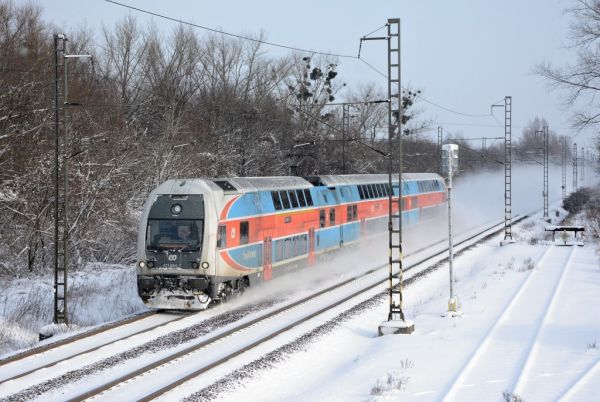
A class 471 CityElefant, still wearing the old original livery, seen here in full speed in wintertime.
Picture from somewhere along the Bohumin to Ostrava line 17.1.2021 by by Petr Štefek.

Still a similar class 471/971 CityElefant, but again with a different painting scheme.
Picture from Praha Masarykovo station 25.5.2012 by Ilkka Siissalo.
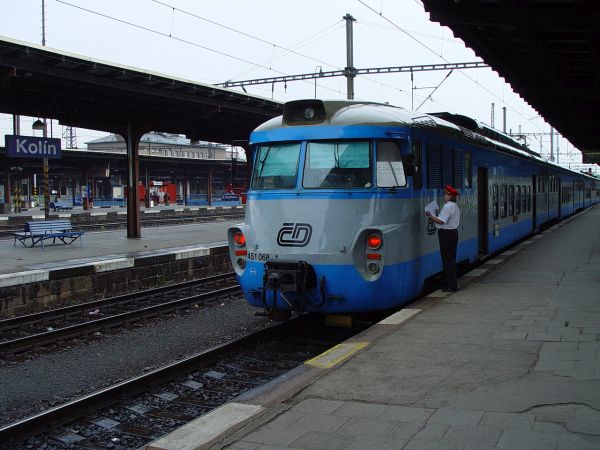
The classes 451/452 electric multiple units were the predecessors of the present day CityElefant trains shown above. Class 451
was from the years 1964 to 1968 and built by Studenka / MEZ. The second series from 1972-73 was listed as class 452 and built by
what then was Tatra Studenka. Originally they were four coach fixed sets for suburban traffic for use near the the capital Prag,
but as time went by, also three and six coach variants were used. The train type was never comfortable: They were extremely noisy,
cold in the winter, they moved abruptly in such ways that standing passengers kept falling during the ride. But there were many
of them and for a long time they were the only trains serving large areas around the city of Prag. This unit in the picture, 451 068
was from the year 1968.
Picture of a four-coach class 451 train at Kolin station 1.6.2003 by Ilkka Siissalo.
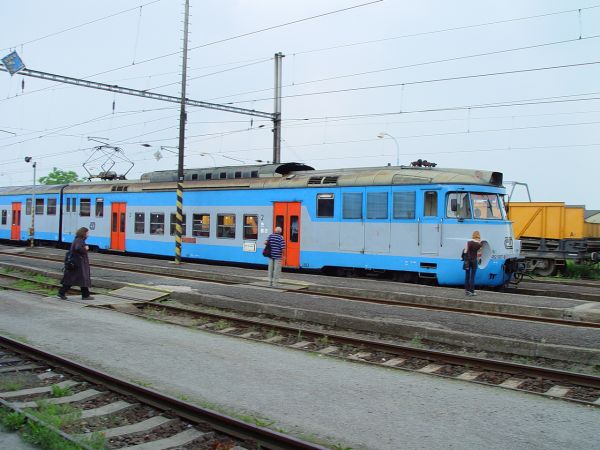
A class 452 electric multiple unit stopping at the station of Čelákovice on its way to Prag (Praha Masarykovo station).
Picture from Čelákovice 1.6.2003 by Ilkka Siissalo.
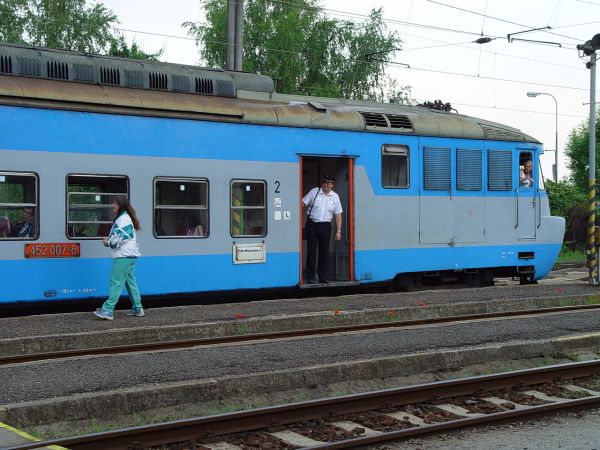
The same class 452 electric multiple unit as shown above, but seen closer by.
Picture from Čelákovice 1.6.2003 by Ilkka Siissalo.
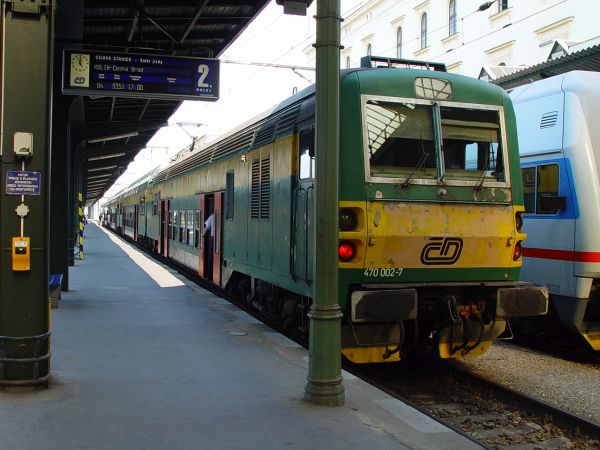
Class 470 double decker electric multiple units were newer than the 451/452 ones shown above, but still not much more comfortable.
These trains, nicknamed "Kraken" were built in 1991 by Vagónka Studénka. Also these trains have by now all been taken out of use.
Picture of a class 470 train at Kolin station 1.6.2003 by Ilkka Siissalo.
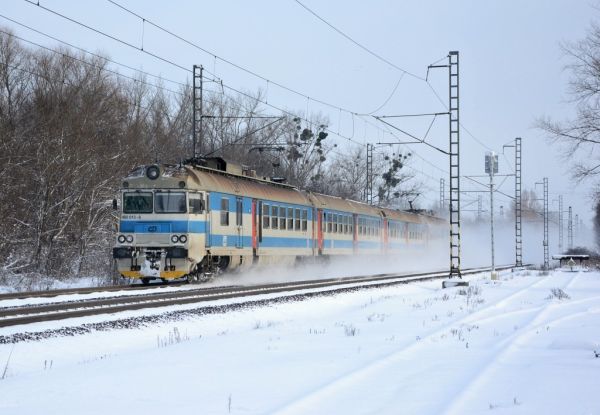
Two class 460 electric multiple units, numbers 460 013 and 014, seen in full speed between Bohumin and Ostrava. The class 460
trains are already quite old machines from the communist era. They were built 1974-78 in what then was Vagónka Tatra n.p. Studénka
(now a part of Škoda). Each motor wagon's power rating is 2000 kW and top speed of the train is 110 km/h. Class 460 is already
fairly rare in Czech Republic, but there are more of them in Slovakia. For pictures of Slovakian class 460 trains, please see the
Slovakia -> "diesel and electric multiple units" section of this picture archive.
Picture from somewhere along the line between Bohumin and Ostrava, 17.1.2021 by Petr Štefek.
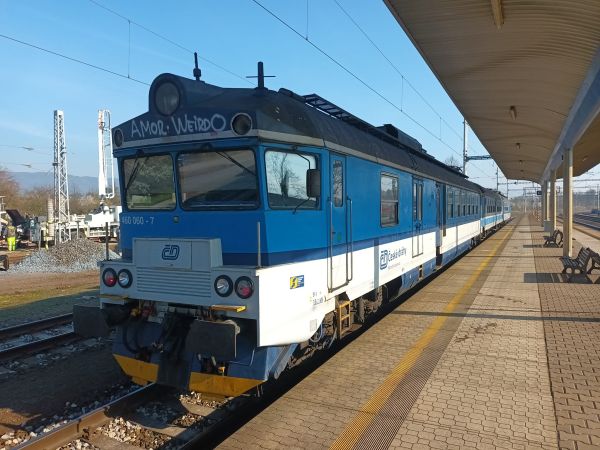
Another class 460 diesel multiple unit. These are quite old already
but some of them are still in use in the areas of Ostrava, Ústí nad Labem and Košicích.
Picture from Lipník nad Bečvou 20.3.2024 by Otto Tuomainen.

